AI Agents Are Rewriting the Enterprise Software Playbook

Executive Summary
AI Agents Will Lead Enterprise Software’s Third Act
Enterprise software is entering its Third Act. The first was client-server, where on-premises applications digitized business processes. The second act, SaaS-based applications, moved them to the cloud, bringing accessibility, scalability, and collaboration. However, both acts shared a common core limitation. They showed users information and waited for humans to act. The user still had to read the dashboard, decide what to do, and manually execute across other SaaS tools.
With the rise of AI agents, enterprise software no longer stops at insight but moves straight to execution. By combining reasoning from large language models (LLMs) with real-time access to APIs and enterprise data, agents can interpret intent, plan multi-step actions, and autonomously complete workflows across systems, all while keeping humans in control of oversight and exceptions. This shift poses a deeper question: If software starts doing the work itself, what becomes of SaaS as we know it?
The answer is not obsolescence, but absorption. SaaS applications are poised to become the foundational platform layer, the hands and feet, for a new and intelligent orchestration layer of AI agents. The user interface, once the crown jewel of SaaS, will cede primacy to the API economy, robust data pipelines, and systems built for agentic learning and trust.
This industry report examines the drivers behind this shift, including SaaS fatigue from tool proliferation, advances in LLMs and API-first infrastructure, and growing demand for productivity. Enterprises today spend billions combating gray work, with 70% of employees wasting up to 20 hours weekly switching between apps. Agents can solve these inefficiencies by orchestrating workflows end-to-end, surfacing the right insights at the right time.
For investors, the opportunity spans horizontal orchestration platforms, incumbents, and vertical domain-specific apps in functions like legal, financial planning and analysis (FP&A), customer support, and sales. With defensibility rooted in execution data, adoption velocity, and trust, we believe agent-native startups represent a once-in-a-decade shift akin to the rise of SaaS itself.
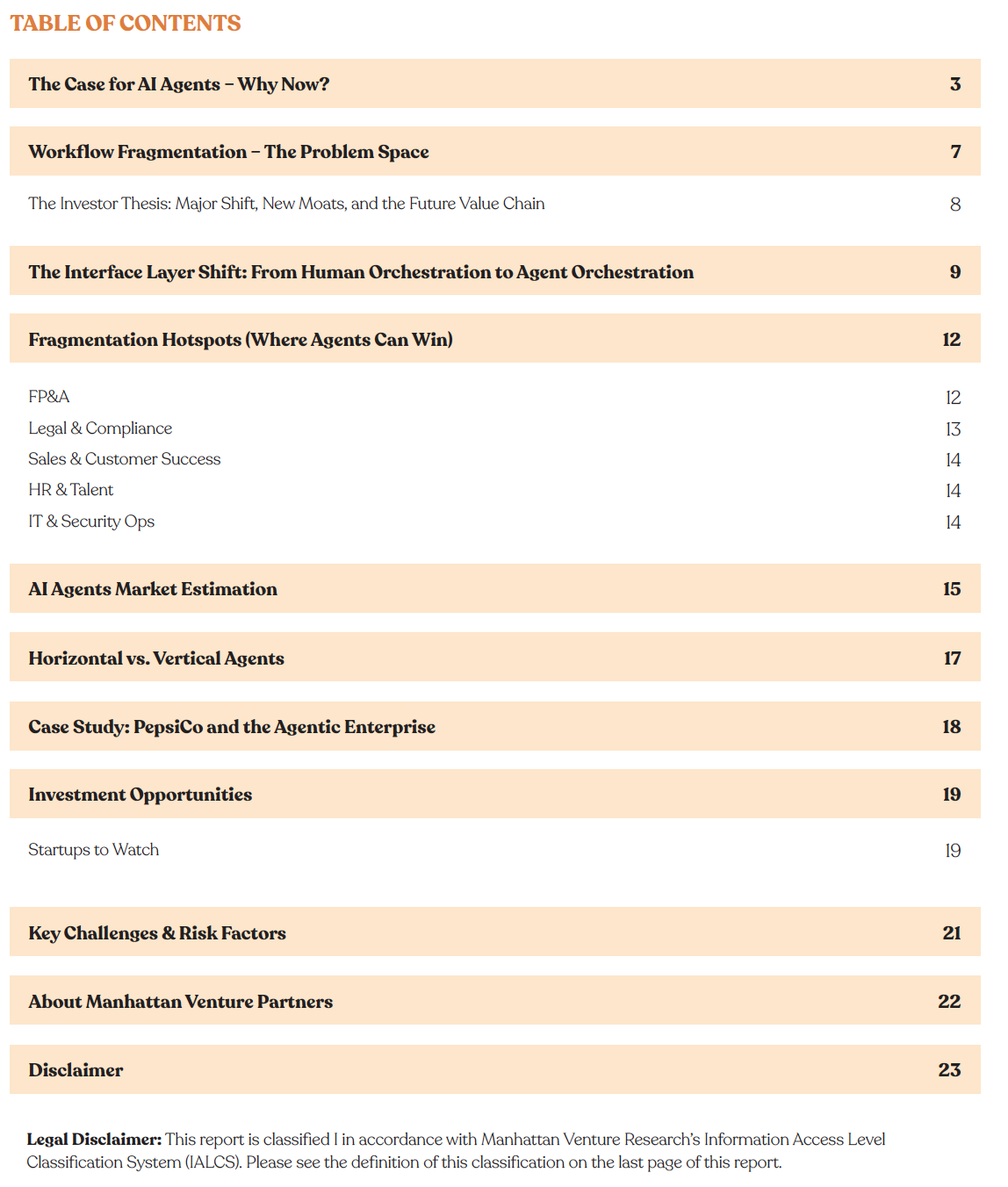
The Case for AI Agents – Why Now?
Enterprise software is at an inflection point. The ‘best-of-breed’ SaaS strategy of the past two decades has created a crippling operational burden. While mid-sized enterprises now use an average of 106 SaaS applications (down from a peak of 112, indicating a struggle with reactive consolidation), the fragmentation is more pronounced than ever, according to the BetterCloud’s State of SaaS Report 2025. The IT function is also stretched thin, with each professional supporting 108 employees, a 31.4% year-over-year increase. This sprawl forces employees to spend 20-30% of their time context-switching and managing administrative ‘SaaS tax,’ which can cost enterprises between $5,000 to $20,000 per custom integration to maintain.
Additionally, controlling the SaaS sprawl has become the biggest concern for enterprises, with such concerns up 55% when compared to 2023, according to the report.
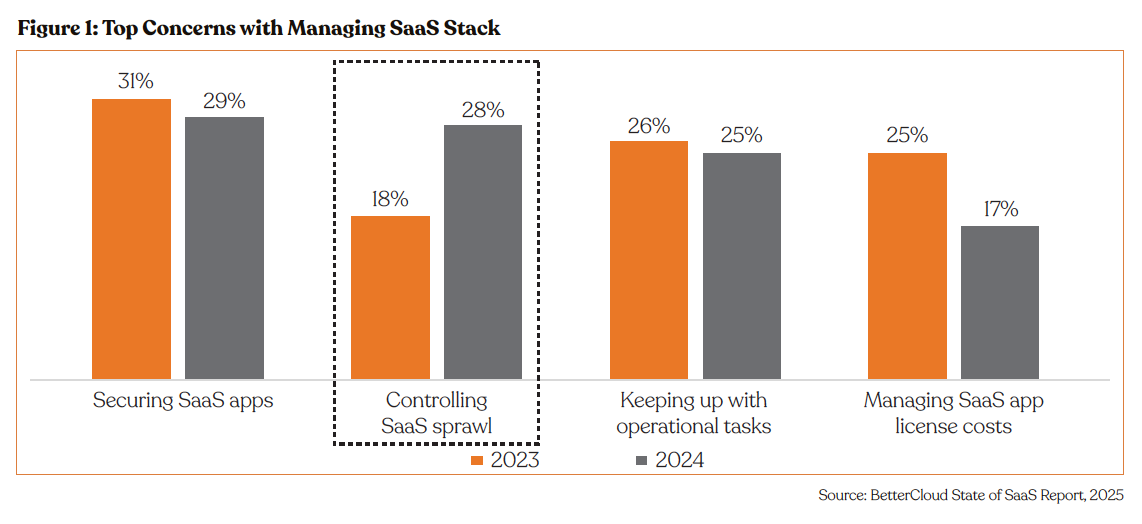
At the same time, advances in AI infrastructure, particularly foundation models, vector databases, and orchestration frameworks, make it possible to create software that doesn’t just passively display information but acts on behalf of the user. AI agents, unlike chatbots, are designed for autonomy and multi-step reasoning, meaning they can set sub-goals, call APIs, fetch and process data, and execute tasks across systems.
Four primary forces converge to make this the moment for AI agents:
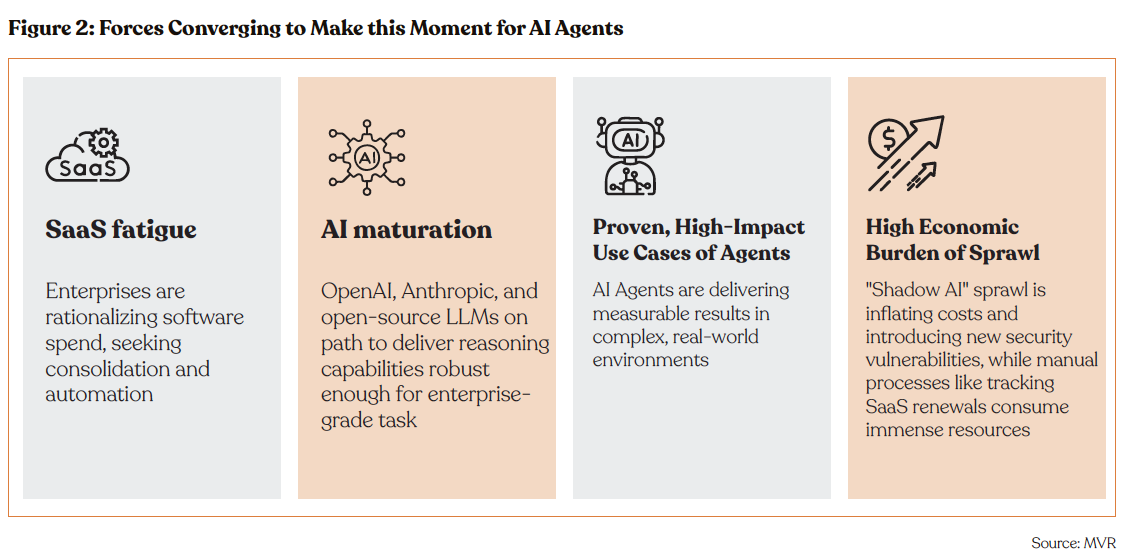
SaaS Isn’t Dead; It Is Taking New Shape
AI agents represent the most significant enterprise software transition since cloud computing, not by replacing SaaS applications, but by making them invisible to end users. The applications remain, but what changes is whether humans interact with them directly or through an intelligent orchestration layer.
This transition follows a reliable pattern in technological evolution. Cloud computing did not eliminate software, it changed where software ran and how it was delivered. Mainframes didn’t vanish when client-server architecture emerged, they became backend systems. Similarly, agents are not replacing Salesforce, Workday, or ServiceNow, they are making them invisible to end users while increasing their strategic value as data and execution substrates.
In the agentic paradigm, the strategic value of a SaaS application will no longer be determined solely by its user interface, but by the robustness of its APIs. A SaaS application’s defensibility will be tied to how easily and powerfully it can be leveraged by AI agents. Companies with well-documented, reliable, and feature-rich APIs will become preferred partners in the agentic ecosystem, increasing their stickiness and strategic importance.
What exactly is an agent?
The term “agent” is often misunderstood, often conflated with simple chatbots or basic automation tools. A system that can answer complex questions using RAG (Retrieval-Augmented Generation) is impressive, but it’s not an agent. As a minimum, an agent must demonstrate the following five features:
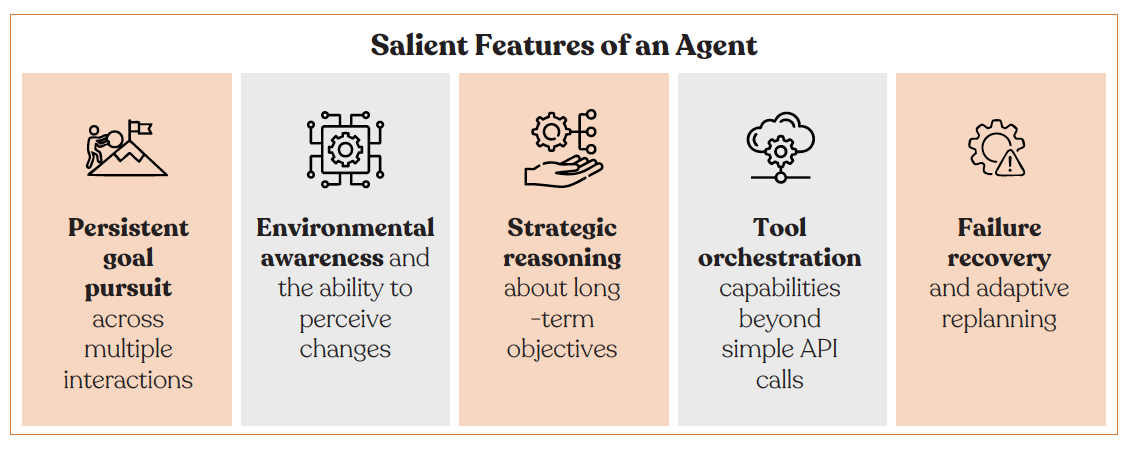


Evolution of AI Systems
We have progressed from Traditional AI’s rigid, rule-based logic, confined to narrow domains like expert systems and basic filters, to Generative AI’s ability to create and communicate based on patterns in vast training data. The present and future frontier is Agentic AI, which marries the reasoning power of foundation models with advanced capabilities for planning, memory, and tool use. This evolution marks the critical transition from systems that merely answer questions or generate content to autonomous agents that can pursue complex goals and take action across digital and physical environments.

Workflow Fragmentation – The Problem Space
If SaaS was the great unbundler of the 2010s, the result in 2025 is a landscape of hyper-fragmented workflows. Each department runs on a patchwork of specialized apps, but the lack of orchestration has created new bottlenecks.

Investor Thesis: New Moats, and the Future Value Chain
The transition from fragmented SaaS to integrated AI Agents is a fundamental architectural shift in enterprise software. This disruption changes existing value chains and creates new ones, presenting a generational opportunity for investors who understand where new, durable moats will be built, how value is being re-aggregated, and which players are positioned to capture it.
Why This Transition Creates New, Deeper Moats
The SaaS era was defined by point-solution moats such as best-in-class functionality, proprietary data within a silo, and sales/distribution networks. AI Agents render many of these moats obsolete while erecting new, more formidable ones.
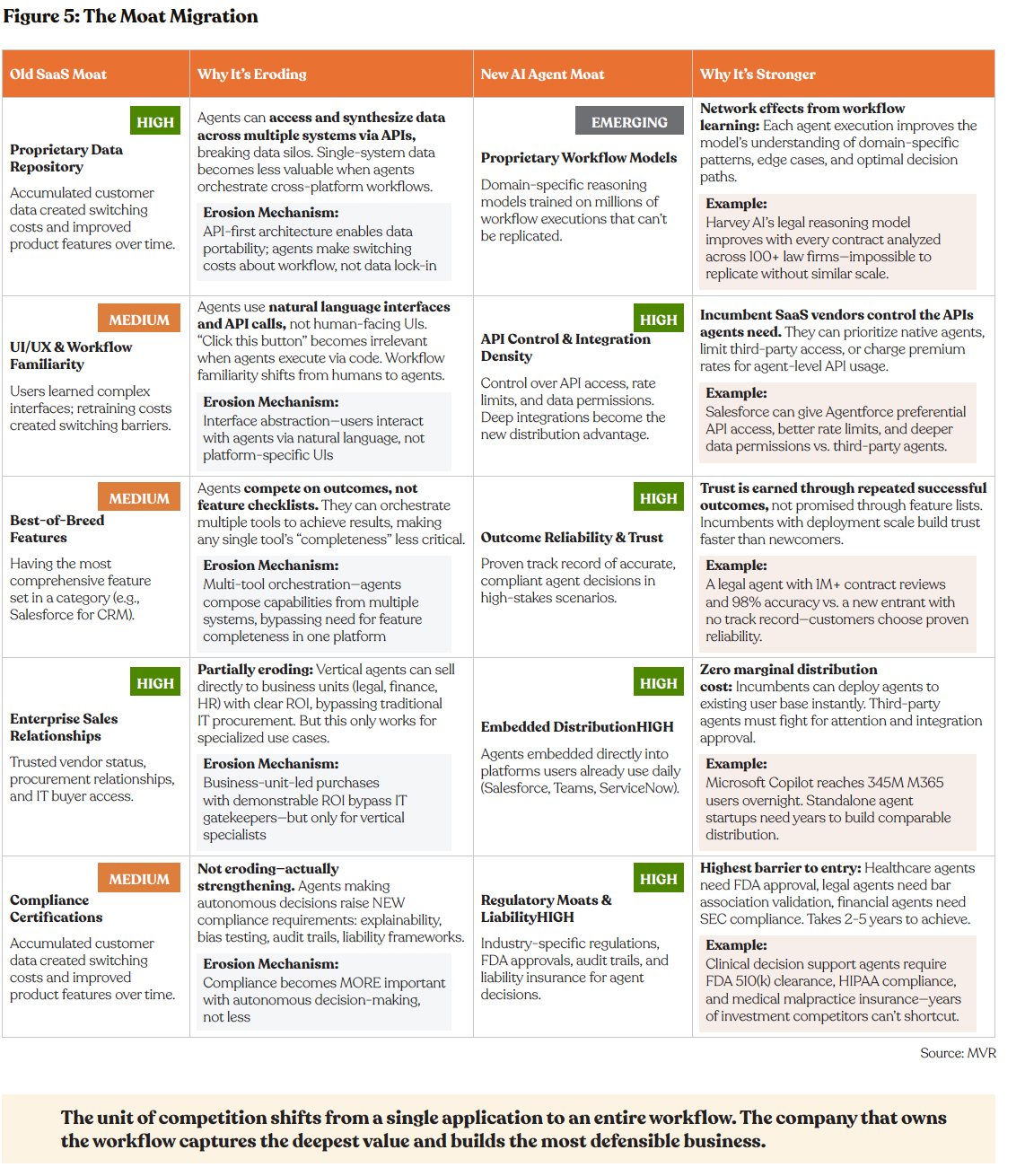
The Interface Layer Shift: From Human Orchestration to Agent Orchestration
The SaaS revolution ushered in an era of unprecedented functional specialization. Each business domain gained a best-in-class tool like Salesforce for CRM, Zendesk for customer support, Stripe for payments, and Jira for engineering, with each optimized for depth within its vertical. However, this specialization introduced a structural inefficiency: humans became the integration layer.
Knowledge workers now spend an estimated 30–40% of their time switching between applications, manually transferring data, and reconciling workflows across siloed systems. The issue was never the quality of the tools themselves, but rather the integration burden shifted onto people.
Agents as the New Orchestration Layer
AI agents fundamentally shift who (or what) performs workflow orchestration. Instead of humans manually coordinating across systems, agents become the intelligent middleware that:
• Maintains context across multiple applications
• Makes decisions about routing and prioritization
• Executes actions across integrated tools
• Adapts dynamically to novel scenarios
Critical distinction: This isn’t about replacing individual SaaS tools. The underlying applications remain specialized. Agents create an abstraction layer that makes the fragmented SaaS landscape feel unified from the user’s perspective.
The Evolution: From Manual to Automated to Intelligent Orchestration
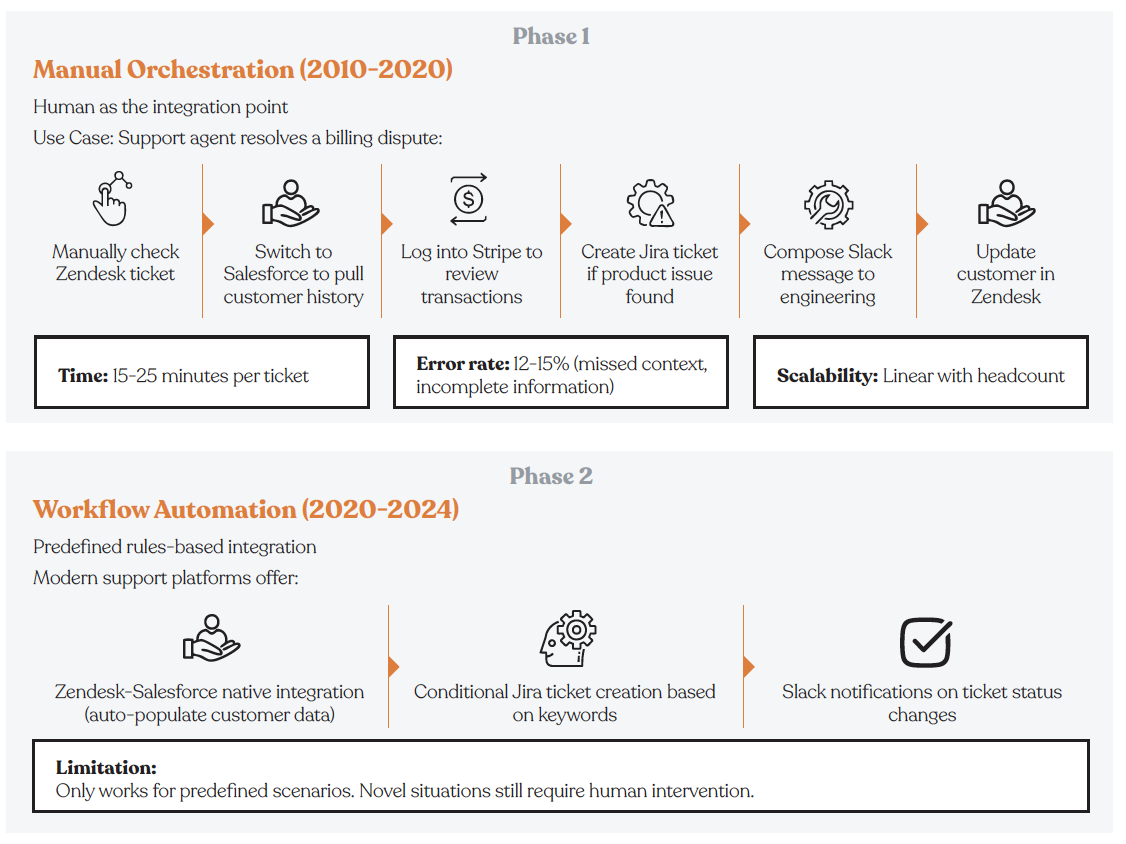
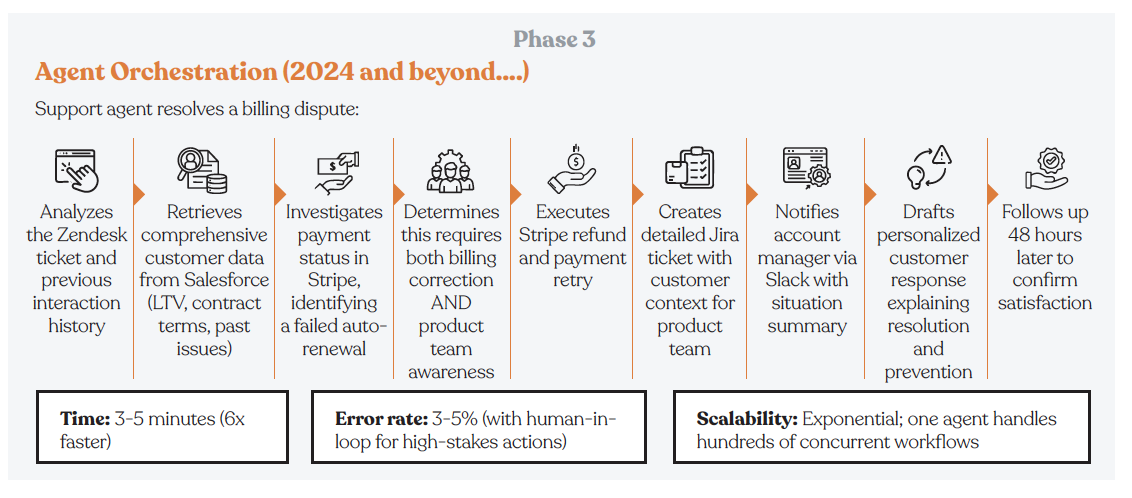
The Value Capture Question: Who Wins?
In tech platform history, whoever controls the ‘starting point’ captures disproportionate value:
• Google owns search intent controls advertising
• iOS/Android owns app discovery controls mobile revenue
• AWS owns infrastructure deployment controls cloud spending
For AI agents, the ‘starting point’ is where users express goals and delegate workflows. Three possible scenarios for how value accrues are as following:
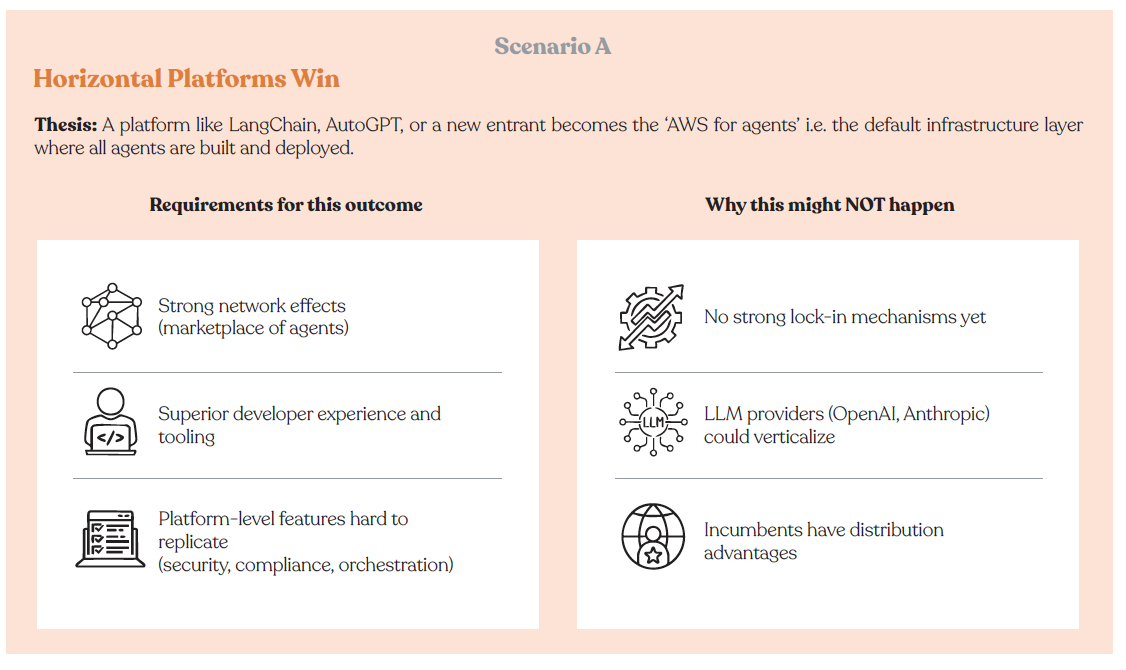

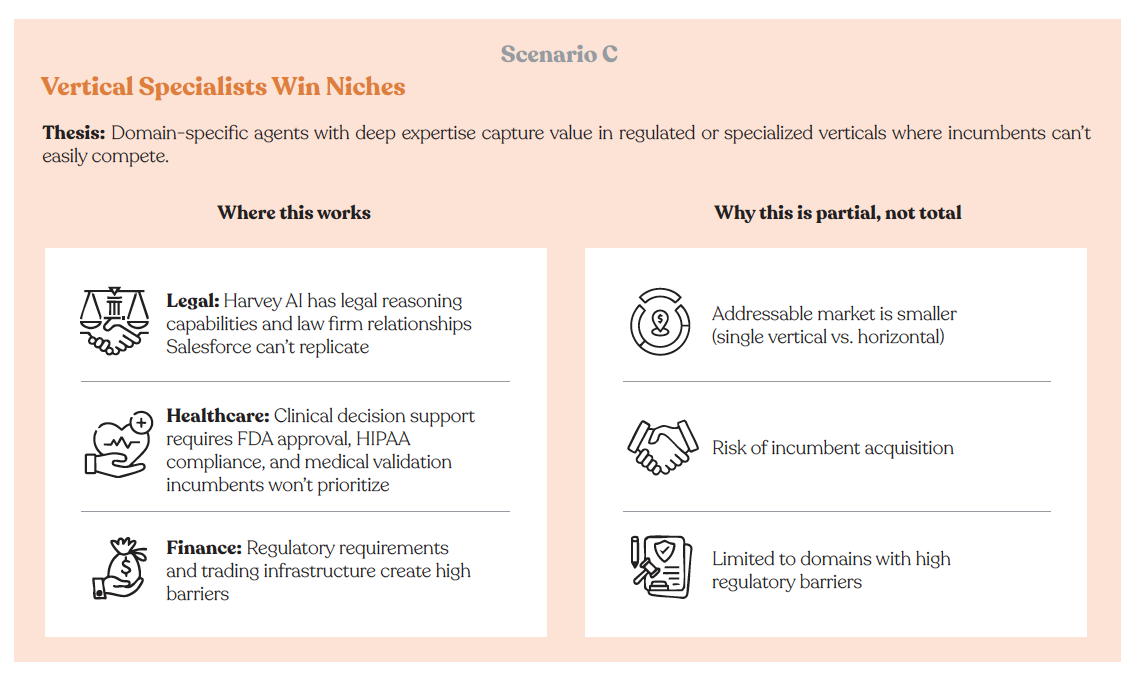
Fragmentation Hotspots (Where Agents are Most Likely to Win)
We analyzed workflows across functions and identified five high-fragmentation, high-value domains most ripe for agent adoption.

Agent Opportunity:
Full-stack financial planning assistants that pull live data from ERP + CRM, run forecasts, and auto-generateboard decks.
· Autonomous reconciliation agents that connect disparate financial systems
· Real-time variance analysis and forecasting without manual spreadsheet work
· Natural language financial reporting across all platforms
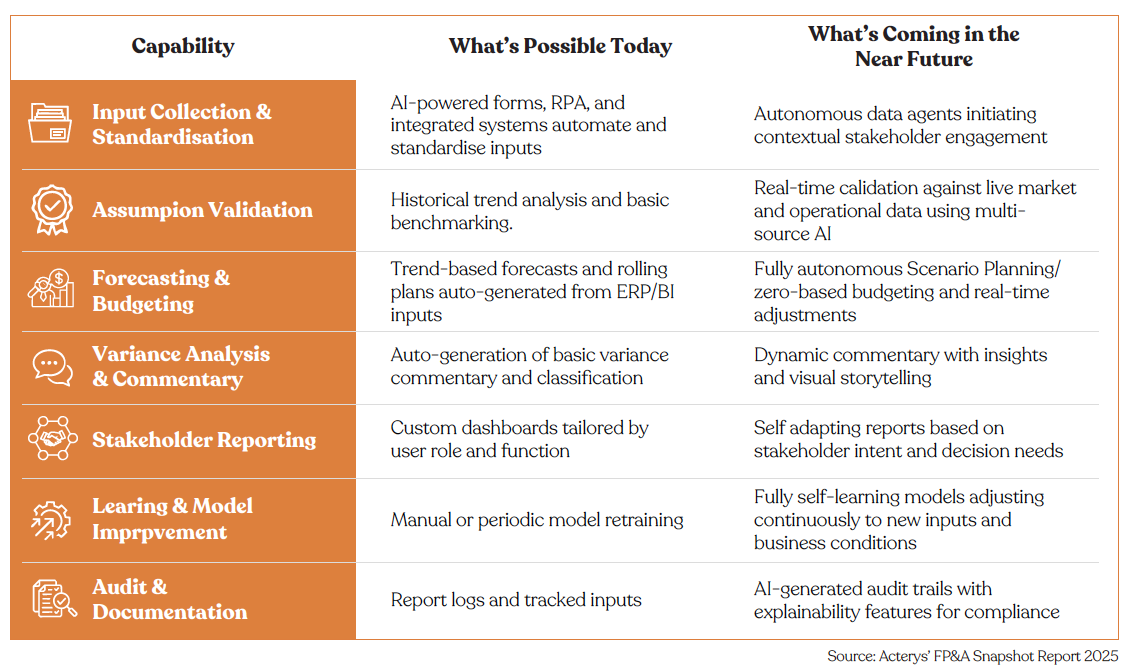
Microsoft is a good example. Within its finance organization, AI agents are starting to power core FP&A functions such as forecasting, variance analysis, reconciliation, and reporting. Forecasting agents have replaced Excel-based modeling with a no-code ML platform. Reconciliation agents automatically match financial records for each account, reducing cycle time from hours to minutes. Analyst agents interpret causes, build visual dashboards, and draft executive narratives.
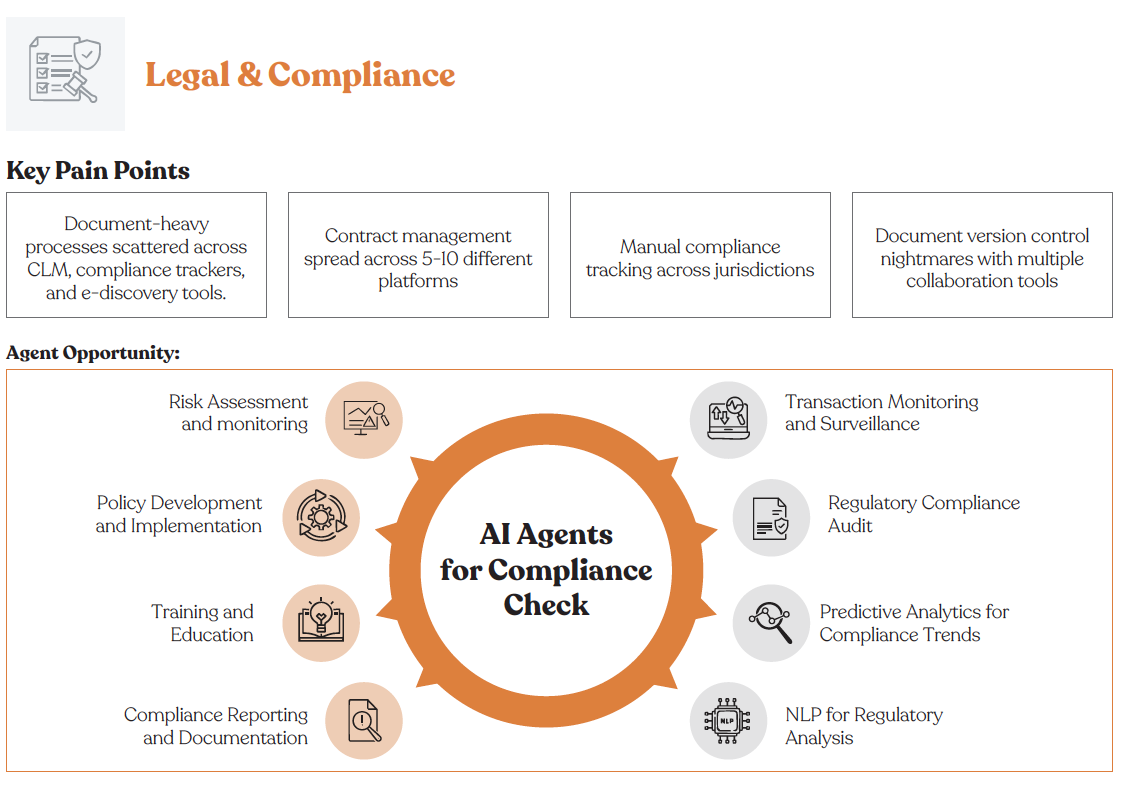

Agent Opportunity:
• Unified customer intelligence agents that aggregate all interactions
• Autonomous lead scoring and routing across multiple data sources
• 85% of customer service reps using AI say it saves them time
• End-to-end sales agents that qualify leads, schedule calls, and orchestrate CS touch points with minimal human involvement

Agent Opportunity:
End-to-end recruitment agents that work across job boards, ATS, and assessment tools
• Employee experience agents that personalize benefits, learning, and career pathing
• Predictive retention agents analyzing signals across all HR systems
• Autonomous recruiting coordinators that manage sourcing screening scheduling onboarding without humans

Agent Opportunity:
• Autonomous threat detection and response across security stack
• SaaS discovery and optimization agents
• Self-healing infrastructure agents that prevent issues before they occur
Market Size & TAM Estimates for AI Agents
AI Agents are emerging as one of the most significant enterprise software opportunities amidst the AI revolution. Even under conservative assumptions, the category is projected to reach a market size of $153.3–$200 billion by 2030, per MVR analysis. This growth is driven by strong alignment with the SaaS market and Software + IT services spend, which underpin much of today’s enterprise technology adoption.
The scale of the opportunity becomes even more compelling when viewed through the lens of broader market dynamics. If AI Agents capture just 1–2% of the projected $10 trillion global SaaS market by 2030 (as estimated by McKinsey & Company), or a similar share of the $5.1 trillion Software + IT services spend, per Gartner and MVR analysis, the category scales rapidly into a high-growth, multi-billion-dollar segment with compounding potential.

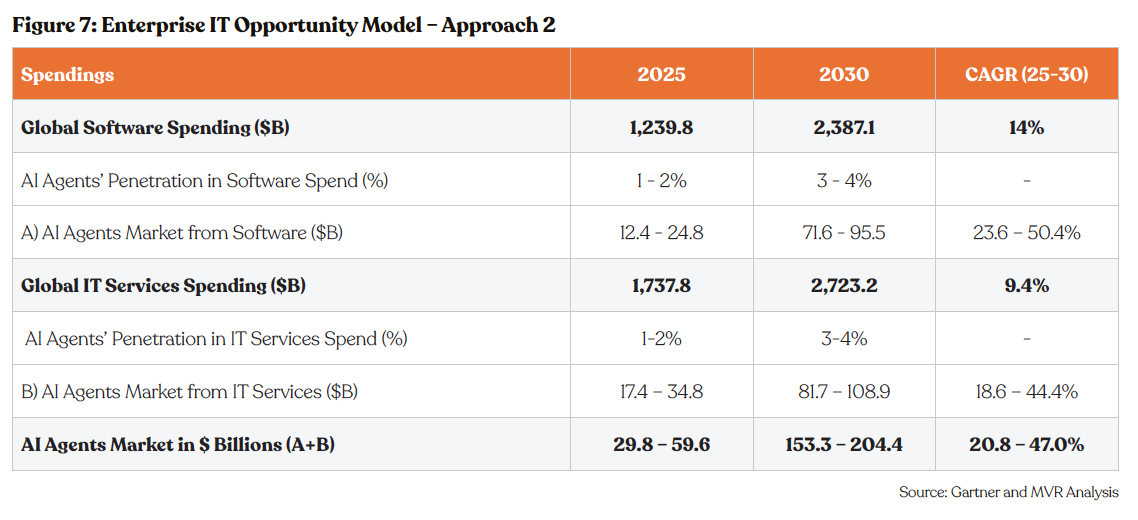
Importantly, these estimates appear conservative when compared to the actual adoption momentum in the real world. Companies deploying AI Agents report 55% efficiency gains and 35% cost reductions, per Salesforce, creating urgent incentives for budget reallocation.
Enterprise sentiment has already moved; 88% of senior executives, per PwC’s May 2025 survey, say AI-related budgets will increase in the coming year due to agentic AI, and 66% of adopters see direct productivity value already. This is not a hypothetical future, but a near-term re-platforming of knowledge work.
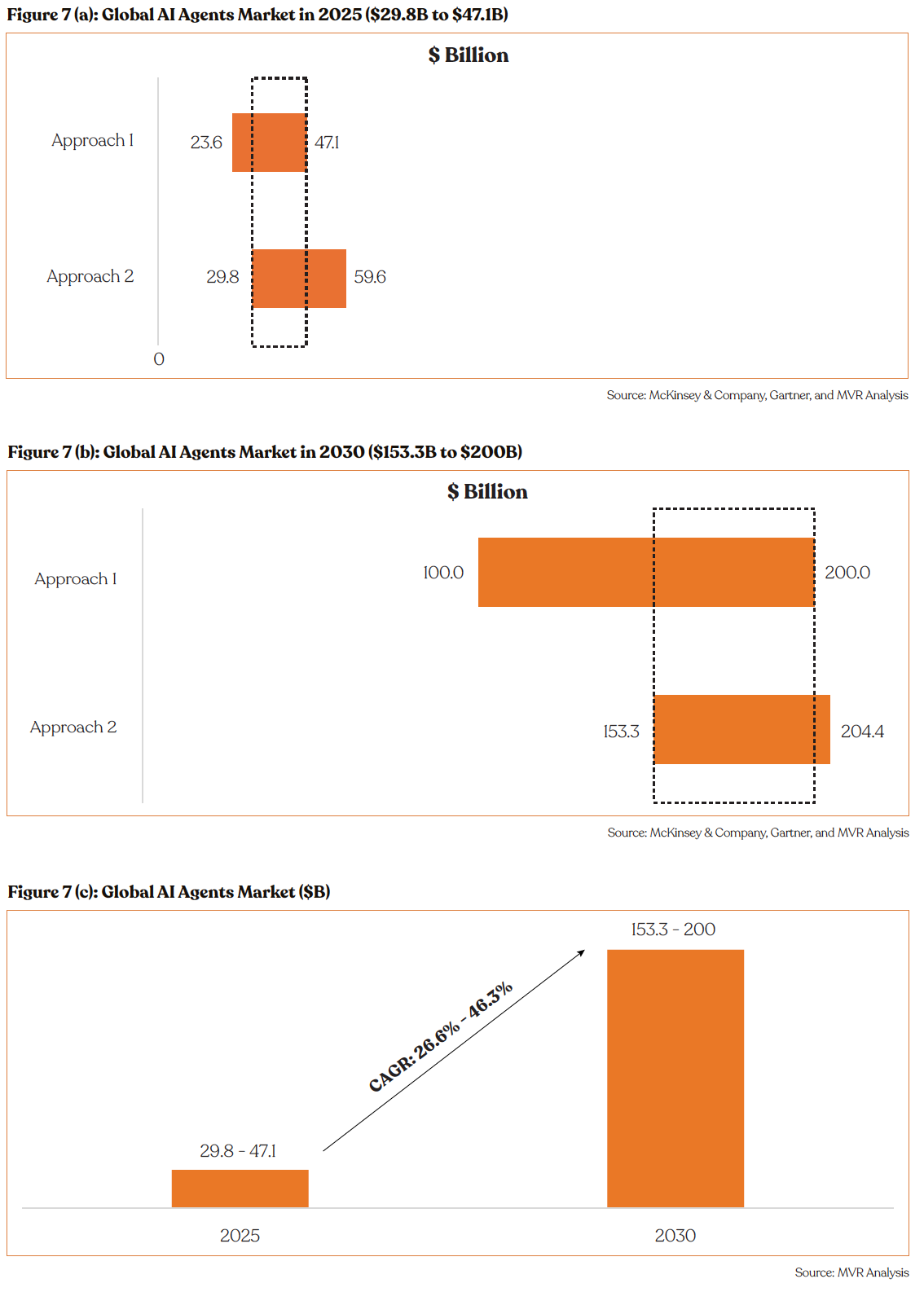
Horizontal vs. Vertical Agents

Case Study
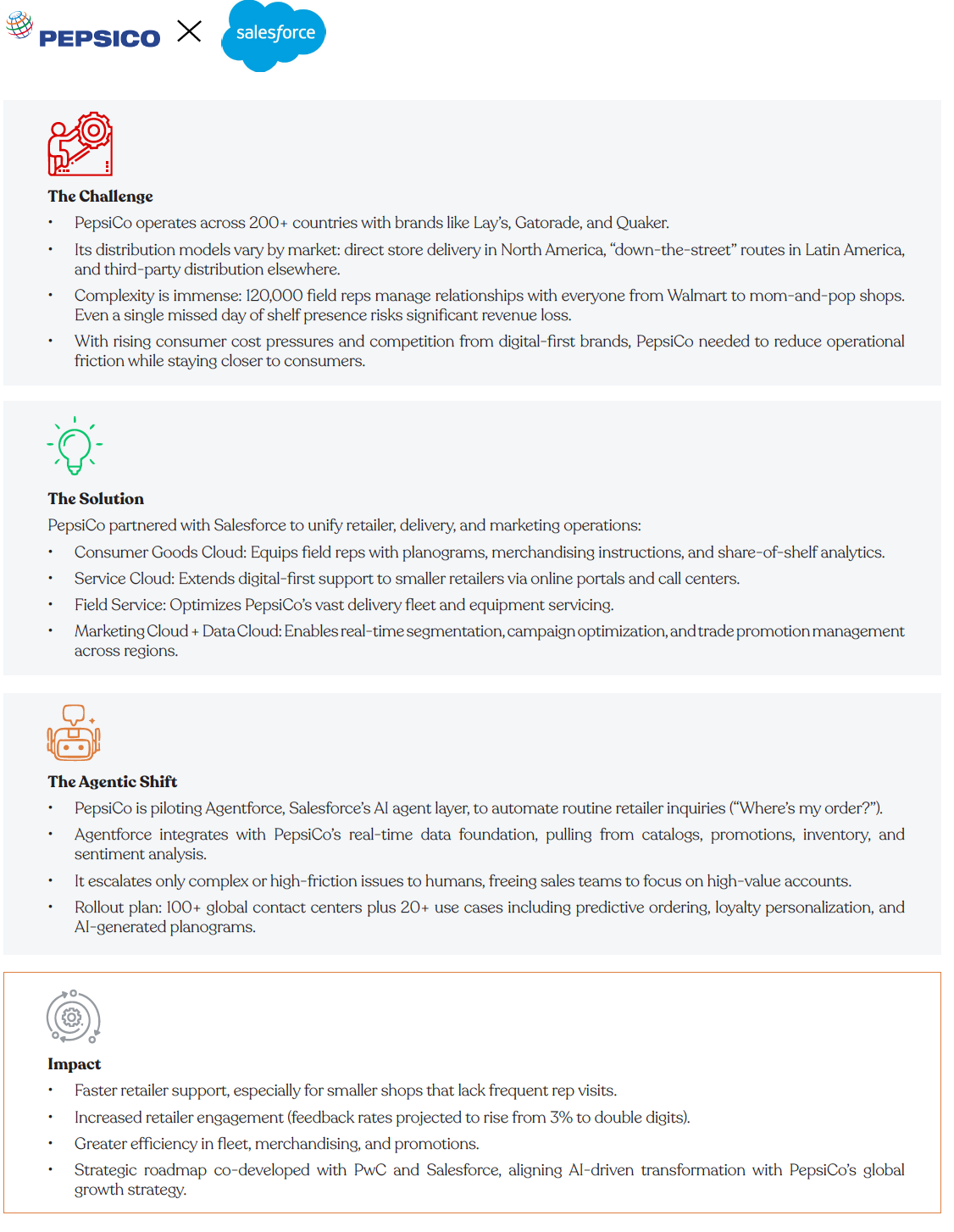
Investment Opportunities
The AI Agent landscape is rapidly evolving, presenting a complex array of investment opportunities. A clear framework is essential to differentiate between foundational bets, vertical-specific disruptors, and potentially crowded application layers. Based on market dynamics and scalability potential, investment focus should be prioritized in two primary domains: Horizontal Infrastructure and Deep Vertical Agents.

Startups to Watch

What it does: Decagon is an AI agent that automates customer support for a business. The company offers a conversational AI platform that fully integrates into a customer’s core business systems and operates as a full, 24/7 agent that can converse with a user over text, understand the context of the inquiry, and be able to automate resolution and actions for the customer fully.
Investment Highlights
• Raised $231M across five rounds in 18 months, with valuation rising from $134M to $1.5B (11x increase).
• Expanded enterprise adoption, with Fortune 500 clients reporting 25–50% cost reductions in customer support.
• Strategic partnership with TaskUs provides large-scale distribution into enterprise call center operations.
• Launched Decagon Voice 2.0 with 65% lower latency and cross-channel memory, enhancing differentiation.
• Repeat investors include Accel, Bain Capital Ventures, and Andreessen Horowitz, signaling sustained confidence.

What it does: Motion offers AI-driven productivity suite with “AI Employees” for executive assistance, sales, and customer support.
Investment Highlights
• AI Employees product reached $10M ARR within three months of its May 2025 launch.
• Serves 10,000+ SMB customers, highlighting rapid adoption at scale.
• Valued at $550M following an oversubscribed Series C.
• Expanded internationally, with structured GTM entry into Latin America.
• Backed by Y Combinator, SignalFire, Scale Venture Partners, and Valor Equity Partners.

What it does: Based in Germany, Parloa offers enterprise-grade AI platform for customer service automation in 137 languages, including voice and biometric authentication.
Investment Highlights
• Quadrupled revenue in 12 months between Series B (2024) and Series C (2025).
• Established North American presence with a New York office, winning Fortune 200 enterprise deals.
• Platform supports 137 languages and dialects, a clear differentiator in global customer support.
• Secured partnerships with PwC, Deloitte, NTT, and Microsoft under its global partner program.

What it does: Norm AI has developed AI-driven compliance automation platform that converts regulations into executable code,
enabling Fortune 100s to operationalize legal and regulatory requirements.
Investment Highlights
• Partnership traction with Salesforce, Microsoft, and New York Life, embedding deeply into enterprise compliance workflows.
• Achieved 288% YoY team scale while entering the UK financial services market, showing early signs of international expansion.
• Proprietary “regulation-to-code” platform differentiates it from rules-based compliance tools, providing defensibility.
Key Challenges & Risk Factors
While the potential of AI Agents is transformative, a prudent investment strategy requires a clear-eyed assessment of the significant hurdles that lie ahead. These challenges span operational, economic, and ethical aspects.

About Manhattan Venture Partners
Our Research Methodology
Manhattan Venture Research provides clients with accurate, timely, and innovative research into the companies and sectors we cover. To that end, we have established an experienced team of analysts, researchers, economists, and industry veterans that focus exclusively on private companies with a proven track record of success. Producing quality research on a private company is uniquely challenging. Our analysts communicate with ex-employees, early investors, VCs, competitors, suppliers, and others to gather valuable information about the company under coverage. This information enables us to create unique financial models that value the underlying company and provide insight to our clients and industry experts, leveraging years of experience working for bulge bracket firms. Manhattan Venture Research reports include business and financial aspects of late-stage companies. These reports include but are not limited to industry overviews, competitor analysis, SWOT analysis, products (existing and in development), management and key directors, risks and concerns, other proprietary channels, historical financials, revenue projections, valuations (using various matrices and valuation recommendation), waterfall analysis, and a capitalization table.
Information Access Level Classification System (IALCS)
Manhattan Venture Research uses an Information Access Level Classification System (IALCS) to make clear the degree of access offered by the company(s) covered in all research reports.
Each research report is classified into one of three categories depending on its classification. The categories are:
I++: The company covered by the research report provided substantial disclosures to Manhattan Venture Partners.
I+: The report was prepared following partial disclosure by the company, including publicly available financial statements, and/or is based on conversations with past or present company employees.
I: All reports are prepared using a mosaic research approach. Not all companies are willing and able to provide substantive access to management and information. In I reports no direct access was granted.
About the Analyst
Santosh Rao has over 25 years of experience in equity research with a primary focus on the technology and telecom sectors. He started his equity research career at Prudential Securities and later moved to Dresdner Kleinwort Wasserstein, Gleacher & Co, and Evercore Partners, where he followed Telecom and Data Services. Prior to joining Manhattan Venture Partners, he was the Managing Director and Head of Research at Greencrest Capital, focusing on private market TMT research. Santosh has an undergraduate degree in Accounting and Economics, and an MBA in Finance from Rutgers Graduate Business School. While at Gleacher & Co he was ranked leading telecom equipment analyst by Starmine/Financial Times
DISCLAIMER
I, Santosh Rao, certify that the views expressed in this report accurately reflect my personal views about the subject, securities, instruments, or issuers, and that no part of my compensation was, is, or will be directly or indirectly related to the specific views or recommendations contained herein.
Manhattan Venture Research is a wholly-owned subsidiary of Manhattan Venture Holdings LLC (“MVP”). MVP may currently and/or seek to do business with companies covered in its research report. Investors should consider this report as only a single factor in making their investment decision. This document does not contain all the information needed to make an investment decision, including but not limited to, the risks and costs.
Additional information is available upon request. Information has been obtained from sources believed to be reliable but Manhattan Venture Research or its affiliates and/or subsidiaries do not warrant its completeness or accuracy. All pricing information for the securities discussed is derived from public information, unless otherwise stated. Opinion sand estimates constitute our judgment as of the date of this material and are subject to change without notice. Past performance is not indicative of future results. MVP does not engage in any proprietary trading or act as a market maker for securities. The user is responsible for verifying the accuracy of the data received. This material is not intended as an offer or solicitation for the purchase or sale of any financial instrument. The opinions and recommendations here in do not consider individual client circumstances, objectives, or needs and are not intended as recommendations of particular securities, financial instruments, or strategies to particular clients. The recipient of this report must make its own independent decisions regarding any securities or financial instruments mentioned herein. Periodic updates maybe provided on companies/industries based on company-specific developments or announcements, market conditions, or any other publicly available information.
Copyright 2025 Manhattan Venture Research LLC. All rights reserved. This report or any portion hereof may not be reprinted, sold, or redistributed, in whole or in part, without the written consent of Manhattan VentureResearch. Research is offered through VNTR Securities LLC.

What’s a Rich Text element?
Heading 3
Heading 4
Heading 5
The rich text element allows you to create and format headings, paragraphs, blockquotes, images, and video all in one place instead of having to add and format them individually. Just double-click and easily create content.
Static and dynamic content editing
A rich text element can be used with static or dynamic content. For static content, just drop it into any page and begin editing. For dynamic content, add a rich text field to any collection and then connect a rich text element to that field in the settings panel. Voila!
How to customize formatting for each rich text
Headings, paragraphs, blockquotes, figures, images, and figure captions can all be styled after a class is added to the rich text element using the "When inside of" nested selector system.
